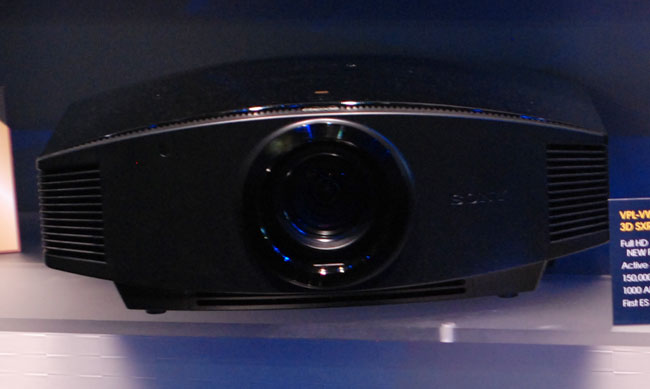
You already watch 3D movies on Sony projectors in theaters, now you can watch them at home on Sony gear at home as well. That seems to be the driving message on Thurday as Sony reemphasized its foothold in 3D content creation, distribution, and display with the introduction of Sony’s first 3D projector on Thursday.
In case you didn’t catch a glimpse of Sony’s first home-theater projector at IFA this year, Sony trotted it out yet for the North American crowd again at CEDIA 2010 in Atlanta, where we had a chance to try it out for ourselves.
The VW90ES uses the same SXRD technology found in many of Sony’s other projectors, but paired with a fast-refreshing 240Hz panel and the same 3D glasses used on its Bravia 3D televisions. Specs include brightness of 1,000 ANSI lumens and a dynamic contrast ratio of 150,000.
The challenge, as with all 3D projectors, will be overcoming the brightness limitations inherent with active-shutter glasses, which diminish on-screen brightness significantly. Even in Sony’s perfectly dark presentation room, the VW90ES left a 3D football game looking slightly overcast. With an extra 300 ANSI lumens on tap, JVC’s pricier X9 3D projector seemed to do a better job preserving the sunshine and lighter feel in Despicable Me. Both projectors use liquid-crystal-on-silicon (LCOS) designs, Sony’s branded as SXRD and JVC’s as D-ILA. Other content, including a reel of upcoming 3D PS3 games and a trailer for the upcoming Green Hornet, seemed significantly happier on the VW90ES, and 2D trailers suffered from no lack of on-screen sizzle. Like Sony’s Bravia TVs, the VW90ES will convert 2D content to 3D, although Sony didn’t demonstrate it at CEDIA.
Sony will debut the VW90ES for “around $10,000” this November, with two pairs of 3D glasses and the necessary IR transmitter included.
Editors' Recommendations
- You Asked: 3D VR, QDEL technology, and TV size vs. quality
- Samsung, Google are attacking Dolby Atmos’ monopoly on 3D sound, and it’s going to get ugly
- What is MPEG-H? The burgeoning 3D audio standard explained
- What is 8D audio, and how can you experience it?
- Look out! 3D TVs could be poised to make a surprising comeback


